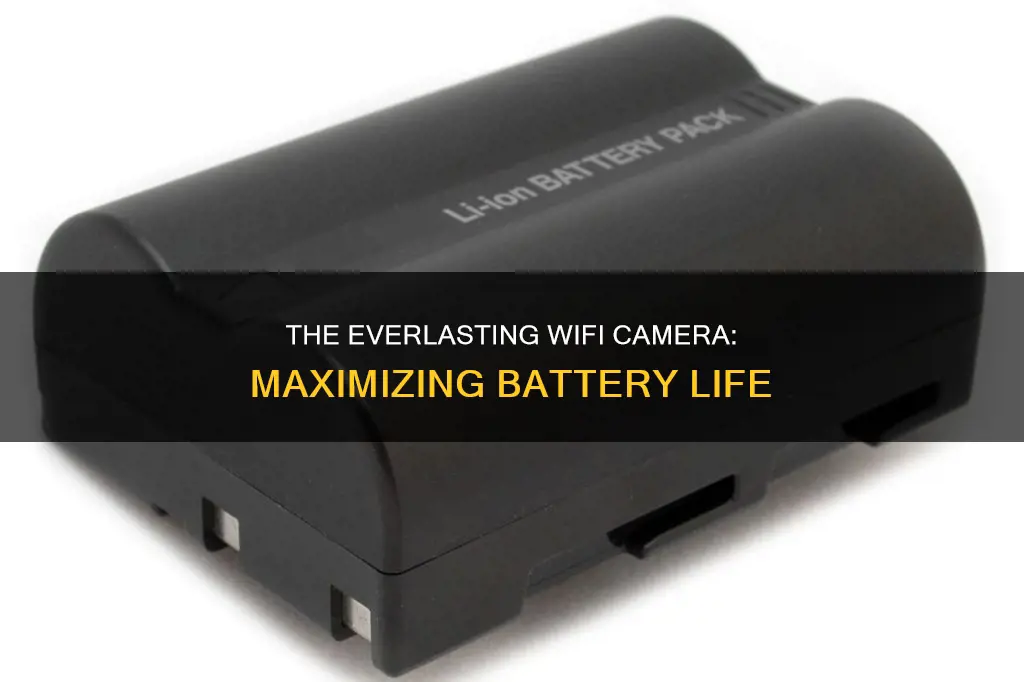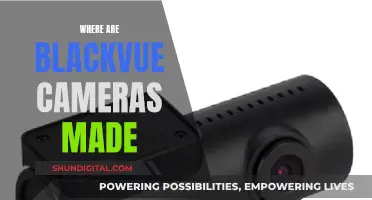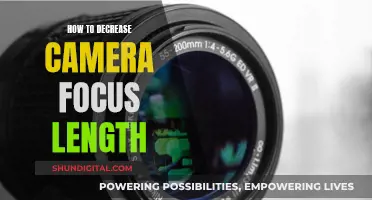
The battery life of a WiFi camera depends on a variety of factors, including usage, battery capacity, settings, temperature, and firmware. On average, the batteries in a battery-powered security camera will last between one and three years, but this can be as little as a few months if the camera is used frequently. Some battery-operated surveillance cameras can last for months or even years without needing to be recharged, depending on usage. The frequency of recharging also depends on the camera's usage, with cameras in high-traffic areas requiring more frequent recharging than those in low-traffic areas.
What You'll Learn

The impact of cold weather on battery life
Cold weather can have a significant impact on the performance and lifespan of batteries, including those used in WiFi cameras. In frigid temperatures, the chemical reactions within the battery slow down, leading to reduced capacity and, in some cases, power loss. This effect is particularly pronounced in lithium-ion batteries, which are commonly used in wireless security cameras.
When temperatures drop below -4°F (-20°C), WiFi camera batteries may be affected in the following ways:
- Reduced battery capacity: In cold weather, the chemical reactions within the battery slow down, resulting in reduced capacity. This means that the battery will not be able to hold as much charge as it would at higher temperatures.
- Faster battery discharge: Cold batteries discharge faster than warmer batteries. This is because the lower temperature causes the battery to produce less current, and it quickly reaches a point where it cannot deliver enough current to meet the demand.
- Increased power consumption: In cold weather, the camera may need to work harder to maintain its connection to the WiFi network, resulting in increased power consumption and faster battery drain.
- Power loss: In freezing weather, the battery power may be reduced by up to 60%, making it difficult to start the camera or device.
To mitigate the impact of cold weather on WiFi camera batteries, it is recommended to:
- Position the camera in a sheltered area or bring it indoors when possible.
- Keep the camera and batteries warm just prior to use. For small batteries, keeping them in a pocket is usually sufficient.
- Use a battery-powered camera specifically designed for cold weather conditions.
- Have a backup battery so that you can replace a depleted battery with a fully charged one.
- Store unused batteries in a cool location to extend their lifespan.
Vicohome Camera Charging: A Step-by-Step Guide
You may want to see also

Motion-activated cameras
There are several factors that influence how long a motion-activated camera's battery will last. The first is camera usage. Cameras in high-traffic areas will lose charge much faster, usually within 2 to 3 months, while those in low-traffic areas can last up to 6 months. The battery capacity also plays a role, with higher-capacity batteries able to last longer between charges.
The settings and features of the camera also impact battery life. For example, continuous video recording will drain the battery much faster than motion-activated recording. Other features that can impact battery life include night vision, outdated firmware, and a weak or unstable internet connection.
To extend the life of your motion-activated camera's battery, consider the following:
- Adjust the motion detection sensitivity to a suitable level.
- Reduce the recording time and set a specific detection zone.
- Ensure the camera is positioned optimally, avoiding high-traffic areas that may trigger unnecessary motion detection.
- Utilise the camera's energy-saving features, such as 'people-only' detection.
- Consider supplementing the camera with solar power or having a backup battery.
By following these tips and choosing a suitable camera with a robust battery capacity, you can ensure your motion-activated camera has a long-lasting battery life and continuous operation.
Charging Camera Batteries: Enercell's Quick Guide
You may want to see also

Solar-powered cameras
Benefits of Solar-Powered Cameras:
- Cost-effectiveness and convenience: Solar power eliminates the need for frequent battery changes or recharging, saving you time and money in the long run.
- Eco-friendliness: Solar energy is a renewable and clean energy source, making it an environmentally friendly choice.
- Remote location installation: Solar-powered cameras can be installed in remote locations without access to electrical outlets or power grids, making them ideal for monitoring sheds, poles, or rural areas.
- Reduced indoor charging: Solar panels reduce the need for frequent indoor charging sessions, which can be inconvenient, especially if a ladder is required to reach the camera.
- Scalability and affordability: Solar panels can be easily added to existing camera systems, and the technology is scalable and affordable for most users.
Factors to Consider:
- Sun exposure: Ensure the solar panel is installed in a location with maximum sun exposure, preferably south-facing and with at least six hours of direct sunlight daily.
- Weather conditions: Solar panels may be less effective in regions far from the equator or during seasons with less sunlight. Keep the panels clean and properly angled to maximise their efficiency.
- Battery life: Most solar security camera batteries last around one to six months on a single charge, but this can vary depending on usage and settings. Consider adjusting settings like motion detection, video resolution, and frame rate to extend battery life.
- Night vision: Solar-powered cameras will use battery power at night. Ensure your camera has sufficient battery life to last through the night, especially during periods of reduced sun exposure.
- Security: Wireless solar-powered cameras may be more susceptible to hacking due to their Wi-Fi connectivity. Prioritise data security and consider a wired connection if possible.
- Video quality: Look for cameras with high resolution, such as 1080p or 2K, to ensure clear and readable footage. Higher video quality may result in increased bandwidth usage and potential lag or glitches.
- Storage: Solar-powered cameras typically offer cloud storage or local storage options. Cloud storage often requires a monthly fee, while local storage uses a separate accessory like a microSD card.
Popular Solar-Powered Camera Options:
- Reolink Argus 3 Pro: Offers excellent solar power, good picture quality, and a simple DIY setup. It is affordable and has customisable settings.
- EufyCam 3: The only camera on the list with built-in solar panels, making installation easier. It boasts 4K video quality and impressive local storage capacity.
- Arlo Pro 3 Floodlight: Compatible with Arlo Solar Panels, this camera has a wide range of camera options and excellent cloud storage.
- Ring Stick Up Cam Solar: Ring offers a diverse range of solar panel accessories, including the Super Solar Panel, which supplies up to 5 watts of power.
- Wyze Cam Battery Pro: Features a built-in spotlight and siren for extra protection and deterrence. Wyze also offers an affordable solar panel add-on.
Charging a VTech Camera: A Step-by-Step Guide
You may want to see also

Battery-operated vs wired cameras
When it comes to choosing between battery-operated and wired security cameras, there are several factors to consider, including cost, convenience, placement options, and maintenance.
Battery-Operated Cameras
Battery-operated security cameras offer greater flexibility in terms of placement as they are not limited by the availability of power outlets. They are generally less expensive to install, especially when you need to stretch wires over long distances. They are easy to move around and can be taken with you if you relocate.
However, battery-operated cameras require regular recharging, which can be inconvenient and may result in downtime if not properly managed. The frequency of recharging depends on various factors, including camera usage, battery capacity, settings, temperature, and firmware. On average, wireless security cameras need to be charged between every 1 to 6 months, with some requiring more frequent recharging every 2 to 3 months.
To improve battery life, consider motion-activated cameras, which only record when motion is detected, or solar-powered cameras that use solar panels to supplement battery power.
Wired Cameras
Wired cameras, on the other hand, provide a more stable power source and internet connection, resulting in less maintenance. They tap into your home's electrical circuit through a wall outlet or hardwiring, eliminating the need for frequent recharging. Wired cameras also offer higher-quality videos and local storage options that don't require a monthly fee.
However, wired cameras have placement limitations as they need to be within reach of power outlets or hardwired into your electrical system. They may require an electrician for installation and are not as portable as battery-operated cameras.
In summary, battery-operated cameras offer convenience and flexibility in placement, while wired cameras provide a more stable power source and higher-quality video but have more limited placement options. The choice between the two depends on your specific needs, budget, and the level of maintenance you are comfortable with.
Charging Cloud Edge Cameras: A Step-by-Step Guide
You may want to see also

Rechargeable batteries
Battery Life and Performance:
- Battery life varies depending on usage, settings, and other factors. On average, rechargeable WiFi camera batteries can last between one and six months per charge.
- Factors affecting battery life include camera usage, battery capacity, security camera settings, temperature, firmware, signal strength, live view duration, and motion detection events.
- To improve battery life, ensure optimal camera placement, enable energy-saving features, use motion-activated recording, and consider solar power or a backup battery.
Charging and Maintenance:
- Recharging times for wireless security cameras typically range from two to ten hours.
- It is recommended to fully charge the battery before initial use.
- Regularly monitor the health of your rechargeable batteries to ensure they are functioning optimally.
- While rechargeable batteries can be left plugged in, it is generally not recommended to do so unnecessarily. Over time, this can reduce the battery's capacity.
- Consider purchasing a compatible desktop or wall charger for your rechargeable batteries to facilitate the charging process.
Technology and Compatibility:
- Rechargeable WiFi cameras use different types of batteries, such as lithium-ion batteries or nickel metal-hydride power cells.
- When choosing rechargeable batteries, consider the number of charging cycles they can provide. Lithium-ion batteries can typically be charged between 300 and 500 times, while nickel metal-hydride power cells can last up to 1,000 charges.
- Ensure that your rechargeable batteries are compatible with your WiFi camera system and any associated apps or software.
- Check the voltage and capacity requirements of your WiFi camera to select suitable rechargeable batteries.
Environmental Considerations:
- Cold weather can significantly impact the performance and lifespan of rechargeable batteries. Lithium-ion batteries, in particular, are sensitive to temperature fluctuations.
- Position your camera in a sheltered area or consider using batteries specifically designed for cold weather conditions to mitigate the effects of low temperatures.
- Water exposure can also impact the longevity of your camera and battery. Ensure that your camera and battery are waterproof or water-resistant if they will be used outdoors or in areas with potential water exposure.
Additional Features:
- Some rechargeable WiFi cameras offer features such as cloud storage, motion detection, night vision, two-way audio, and AI detection.
- When selecting rechargeable batteries, consider the specific features and functionality you require for your WiFi camera system.
Troubleshooting 101: Camera and Charger Malfunctions
You may want to see also
Frequently asked questions
The battery life of a Wi-Fi camera varies depending on usage and settings. On average, a battery-operated security camera will last between one and three years, but this can be as little as a few months if used frequently.
Depending on usage, Wi-Fi cameras need to be charged anywhere from once a month to once every six months.
Charging times for Wi-Fi cameras vary between two and ten hours. Cameras that require more frequent charging tend to charge faster.
To improve battery life, you can:
- Ensure the camera is in a sheltered area with a strong signal to the connecting hub.
- Limit the use of live view.
- Adjust the motion detection settings to reduce recording time and set a detection zone.
- Use solar panels to charge the camera.







